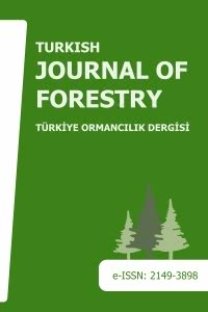Havasal LIDAR verileri kullanılarak meşcere parametrelerinin tahmin edilmesi
taban alanı, çap, ormanlar, korelasyon analizleri, iğne yapraklı ormanlar, kestirim, orman plantasyonları
Estimation of forest stand parameters using airborne LIDAR data
basal area, diameter, forests, correlation analysis, coniferous forests, estimation, forest plantations,
___
- Akay, A.E., Oguz, H., Karas, I.R., Aruga, K., 2009. Using LIDAR technology in forestry activities. Environmental Monitoring and Assessment, 151:1-4, 117-125.
- Akay, A.E., Wing, M.G., Sessions, J., 2012. Estimating structural properties of riparian forests with airborne lidar data, International Journal of Remote Sensing, 33:22, 7010-7023.
- Carson, W., Andersen, H.E., Reutebuch, S.E., McGaughey. R.J. 2004. LIDAR applications in forestry: An overview. Proceedings of the Annual ASPRS Conference, Denver, May 23-28, 2004. American Society of Photogrammetry and Remote Sensing, Bethesda, MD.
- García, M., Riaño, D., Chuvieco, E., Danson, F.M., 2010. Estimating biomass carbon stocks for a Mediterranean forest in central Spain using LIDAR height and intensity data. Remote Sensing of Environment, 114:4, 816830.
- Gobakken, T., Næsset, E., 2004. Estimation of diameter and basal area distributions in coniferous forest by means of airborne laser scanner data. Scandinavian Journal of Forest Research, 19, 529-542.
- Gobakken, T., Næsset., E., 2005. Weibull and percentile models for LIDAR-based estimation of basal area distribution. Scandinavian Journal of Forest Research, 20:6, 490-502.
- Goncalves-Seco, L., Gonzalez-Ferreiro, E., Dieguez-Aranda, U., Fraga-Bugallo, B., Crecente, R., Miranda, D., 2011. Assessing the attributes of high-density Eucalyptus globulus stands using airborne laser scanner data. International Journal of Remote Sensing, 32:24, 9821-9841.
- González-Ferreiro, E., Diéguez-Aranda, U., Miranda, D., 2012. Estimation of stand variables in Pinus radiata D. Don plantations using different LIDAR pulse densities. Forestry, 85:2, 281-292.
- Harding, D.J., Lefsky, M.A., Parker G.G., Blair, J.B., 2001. Laser altimeter canopy height profiles: methods and validation for closed-canopy, broadleaf forest. Remote Sensing of Environment, 76, 283297.
- Heurich M., Thoma, F., 2008. Estimation of forestry stand parameters using laser scanning data in temperate, structurally rich natural European beech (Fagus sylvatica) and Norway spruce (Picea abies) forests. Forestry, 81, 645-661.
- Hofton, M.A., Rocchio, L.E., Blair J.B., Dubayah, R., 2002. Validation of vegetation canopy LIDAR sub-canopy topography measurements for a dense tropical forest. Journal of Geodynamics, 34:34, 491502.
- Jaskierniak, D., Lane, P.N.J., Robinson, A., Lucieer, A., 2011. Extracting LIDAR indices to characterise multilayered forest structure using mixture distribution functions, Remote Sensing of Environment 115, 573585.
- Kwak, D.A., Lee, W.K., Cho, H.K., Lee, S.H., Son, Y., Kafatos, M., Kim, S.R., 2010. Estimating stem volume and biomass of Pinus koraiensis using LIDAR data. Journal of Plant Research, 123:4, 421-432.
- Lefsky, M.A., Cohen, W.B., Parker, G.G., Harding, D.J., 2002. Lidar remote sensing for ecosystem studies, BioScience, 52, 1930.
- Mathieu, D., Thiery, C., Meriem, F., 2011. The use of terrestrial LIDAR technology in forest science: application fields, benefits and challenges, Annals of Forest Science , 68, 959-974.
- Özdemir, İ., Donoghue, D.N.M., 2013. Modelling tree size diversity from Airborn Laser Scanning using Canopy Height Models with image texture measures. Forest Ecology and Management, http://dx.doi.org/10.1016/j.foreco.2012.12.044
- Parker, G.G., Harding, D.J., Berger, M.L., 2004. A portable LIDAR system for rapid determination of forest canopy structure, Journal of Applied Ecology, 41:4, 755-767.
- Popescu, S.C., 2011. Lidar Remote Sensing, Advances in Environmental Remote Sensing, Sensors, Algorithms, and Applications, Ed: Qihao Weng, CEC Pres, Taylor-Francis series in Remote Sensing Applications, UK, 589 s.
- Thomas, V., Oliver, R.D., Lim, K., Woods. M., 2008. LIDAR and Weibull modeling of diameter and basal area, The Forestry Chronicle, 84, 866-875.
- Watt, P.J., Donoghue, D.N.M., 2005. Measuring forest structure with terrestral laser scanning, İnternational Journal of Remote Sensing, 26, 1437-1446.
- Zhao, K., Popescu, S., Nelson, R., 2009. Lidar remote sensing of forest biomass: A scale-invariant estimation approach using airborne lasers, Remote Sensing of Environment, 113, 182196.
- Zimble, D.A., Evans, D.L., Carlson, G.C., Parker, R.C., Grado, S.C., Gerard, P.D., 2003. Characterizing vertical forest structure using small-footprint airborne LIDAR, Remote Sensing of Environment, 87, 171182.
- ISSN: 1302-7085
- Yayın Aralığı: Yılda 2 Sayı
- Başlangıç: 2000
Kağıt üretiminde CaCO3 dolgu maddesinin kimyasal tutunması üzerine bir araştırma
Arif KARADEMİR, Hülya VARLIBAŞ, MUSTAFA ÇİÇEKLER
ALKAN GÜNLÜ, İLKER ERCANLI, Emin Zeki BASKENT, Muammer ŞENYURT
Eğilmeye çalışan budaklı kirişlerin sonlu elemanlar modelleri
Ergün GÜNTEKİN, TUĞBA YILMAZ AYDIN
Kastamonu'daki hastane bahçelerinin peyzaj tasarımlarının değerlendirilmesi
ÇİĞDEM SAKICI, Suzan ÇELİK, Özkan KAPUCU
Kavak (Populus nigra x Populus deltoides) odunundan selüloz nanokristalit eldesi
Nilgül ÖZMEN, Nihat Sami ÇETİN, Nasır NARLIOĞLU
SERKAN GÜLSOY, ÖZDEMİR ŞENTÜRK, M. Güvenç NEGİZ
Orman köylerinde kooperatifçiliğin gelişimine etki eden etmenler
HASAN ALKAN, MEHMET EMİN DEMİR
SERKAN GÜLSOY, Gülcan ÖZKAN, KÜRŞAD ÖZKAN, MUSA GENÇ
Yersel lazer tarama ile tek ağaç özelliklerinin belirlenmesi
